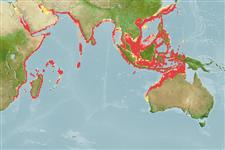Common names from other countries
>
Eupercaria/misc (Various families in series Eupercaria) >
Nemipteridae (Threadfin breams, Whiptail breams)
Etymology: Parascolopsis: Greek, para in the side of + Greek, skolos = stake + Greek, ops = appearance (Ref. 45335).
More on authors: Jordan & Richardson.
Issue
Distribution of this species is being updated. Use Stocks definition as guide for species range.
Environment: milieu / climate zone / depth range / distribution range
экология
морской демерсальный; немигрирующий; пределы глубины 25 - 264 m (Ref. 9820). Tropical; 30°N - 28°S, 31°E - 136°E (Ref. 3810)
Western Pacific: southern Japan, Taiwan, the Philippines and Indonesia (northern Sulawesi),
Size / Вес / Возраст
Maturity: Lm ? range ? - ? cm
Max length : 35.0 cm TL самец/пол неопределен; (Ref. 5450); common length : 35.0 cm TL самец/пол неопределен; (Ref. 5450)
колючие лучи спинного плавника (общее число) : 10; членистые (мягкие) лучи спинного плавника (общее число) : 9; колючие лучи анального плавника: 3; членистые (мягкие) лучи анального плавника: 7. Head scales reaching forward to between middle of eyes. Posterior margin of preopercle more or less vertical, or sloping forward slightly. Lower limb of preopercle naked. Posterior margin of suborbital serrate, a small spine at upper corner. Pectoral fins long, reaching to or almost to level of anus. Pelvic fins long, reaching to level of anus. Color: Body pinkish. An elongate blotch at origin of lateral line. Upper axis of pectoral fin black. Pectoral and caudal fin yellowish.
Benthic on sand or mud bottoms in offshore waters (Ref. 30573, 48635). Feeds mainly on benthic invertebrates. Minimum depth reported taken from Ref. 30573.
Life cycle and mating behavior
Maturities | размножение | Spawnings | Egg(s) | Fecundities | личинки
Miyamoto, K., C.D. McMahan and A. Kaneko, 2020. Parascolopsis akatamae, a new species of dwarf monocle bream (Perciformes: Nemipteridae) from the Indo-West Pacific, with redescription of closely related species P. eriomma. Zootaxa 4881(1):91-103. (Ref. 123359)
Статус Красного Списка МСОП (Ref. 130435)
CITES (Ref. 128078)
Not Evaluated
Угроза для людей
Harmless
Использование человеком
рыболовство: рыболовство как средство для существования
дополнительная информация
инструменты
Специальные отчеты
Скачать в формате XML
ресурсы в Интернет
Estimates based on models
Preferred temperature (Ref.
115969): 19.8 - 28.1, mean 24.9 (based on 677 cells).
Phylogenetic diversity index (Ref.
82804): PD
50 = 0.5002 [Uniqueness, from 0.5 = low to 2.0 = high].
Bayesian length-weight: a=0.02089 (0.01189 - 0.03673), b=2.99 (2.84 - 3.14), in cm Total Length, based on LWR estimates for this species & (Sub)family-body (Ref.
93245).
Trophic level (Ref.
69278): 4.2 ±0.29 se; based on food items.
устойчивость к внешним воздействиям (Ref.
120179): средний (среднего размера), минимальное время удвоения популяции 1.4-4.4 года (Preliminary K or Fecundity.).
Fishing Vulnerability (Ref.
59153): Low vulnerability (25 of 100).
